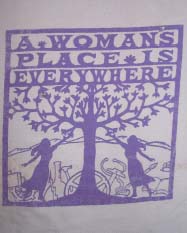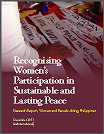A Part of the Women Making Airwaves for Peace:
A Workshop on Engendered Peace Journalism
Duration: Two hours
Introduction:
Peace does not have a singular definition, because it does have many facets, and is given meaning through people’s experiences. Peace is often discussed within the context of war, yet it is more than that, as participants in the past three trainings have shared. As the first session of the Principles and Values of Engendered Peace Journalism made Popular through Community Radio, it seeks to define peace through participants’ experience; it seeks to strengthen the links of peace to other concepts that contribute to peace in people’s lives. At the end of the two hour session the participants should have been able to:
- Share their experiences and definitions of peace and conflict
- Identify the factors that influence the presence or absence of peace
Session Topics:
- Introduction: Peace as Defined by Experience
- Activity 1: Word Association: What does peace mean to us?
- Activity 2: Peace Slogans: Agree or disagree?
- Women’s Visions of Peace (Lecture Discussion)
- Definitions of Peace
- Factors the Influence the Presence and Absence of Peace
- Impact of Peace and Unpeace in People’s Lives
- Making Women Visible: Women’s Participation in Peace Building
- LCD and computer for power point presentation
- Space for small group discussions (which could be separate from the main session hall)
Session Plan:
| Activity/ Topic | Duration | Teaching Aids/Material |
| Topic 1: Introduction: Peace as Defined by Experience | White board, white board marker | |
| Activity 1: Word association: What does peace mean to us? | 15 minutes | Metacards, permanent markers |
| Activity 2: Peace Quote: Agree or Disagree? | 45 minutes | t-shirts / peace quotes: Peace in the world begins at home; Equality, development, peace; A woman’s place is everywhere |
| Topic 2: Women’s Visions of Peace (Lecture-discussion) | 1 hour | Slide Presentation (optional) Text for Trainers (as guide) |
Topic 1: Introduction - Peace as Defined by Experience
Activity 1: Word association: What does peace mean to us?
Word association is a collective exercise in defining peace from the experience and perspective of the participants. Instructions to this quick activity are as follows:
- Divide the plenary in two groups (as much as possible have an equal number of participants in each group)
- Write the word: PEACE on the board, and ask the group to do a few minutes of brainstorming of what PEACE means to them.
- After a few minutes of brainstorming, have the participants form two lines facing the board
- On your signal, the groups start taping their words that they have written on metacards that they associate with peace, as they tape their responses to the board they are to ensure that there is no duplication
People have along list of definitions and associations of peace, showing the diversity of definitions and association’s people have with peace. It is sometimes even talked about in its’ contrast in terms of unpeace or conflict. They speak of it as it exists in their daily life, in terms of how they think it should be maintained. Participants’ responses may be clustered in the following categories:
- Requisites
- Needed to maintain
- How peace is experienced in daily life
- As an issue that involves all people (or women only)
Activity 2: Buzz Group Discussion: Peace Slogans / Quotes: Do I Agree or Disagree? Why?
There have been many campaigns that speak of peace, our need for it etc. – all of these are ways to popularize the concept. What is important to reflect on is –“Do we agree or disagree with the concepts?
Instructions:- Divide the participants in groups of four or five. Give them a t-shirt, one poster or sticker that has a peace quote, like the following:
- Slogans on shirts:


- Other Peace quotes that may be used
- Ayaw ko awaya kay gamay ko.” (Don’t quarrel me because I am small) 6-year old girl, youngest of cousins (3 boys 8 – 9 years old and 1 girl)
- There is peace when there’s fish on the table.” 30-year old father, tricycle driver.
- Slogans on shirts:
- Within the groups participants are to discuss the following question: “Do we agree or disagree with the slogan or quote? Why?”
- Ask the groups to summarize their discussion for the plenum in a short creative presentation: skit, dance, poetry or song
- Plenary presentation
Reaction to the slogans helps surface participants thoughts and feelings around concepts that relate to peace as a way to maintain it or its requisite, these concepts are: EQUALITY and DEVELOPMENT. It widens the definition of peace for us that goes beyond the absence of war, and links the discussion to other social issues that also affect the experience of peace.
Topic 2: Women’s Visions of Peace (Lecture-Discussion)
The lecture discussion is not intended to replace the definitions of peace that participants shared; it is only a way of summarizing participants’ responses. Definitions shared in this discussion is a cumulative list of definitions from a research conducted by the facilitator, as well as additional input coming from the Cagayan de Oro batch of the workshop. It discusses the following:
- Definitions of Peace
- Factors the Influence the Presence and Absence of Peace
- Impact of Peace and Unpeace in People’s Lives
- Making Women Visible: Women’s Participation in Peace Building
Synthesis Points:
Peace has a variety of meanings it is defined by our context, experience of conflict, equality and development. As media practitioners it is important to examine our own vision and definition of peace, because we do play a huge role in how we share and promote it to others. Are we sharing a holistic view of peace (or the lack of it) as it is experienced by men and women, within and outside the home? Do we promote peace or sensationalise conflict? What frames or pictures of peace building do we share? How is peace efforts of men and women shared?
Hand outs: Text for trainers (link to trainers’ text)
The different themes, notes, and examples used by the trainer is based on the research conducted by facilitator in 2005-2006 and reinforced during the discussions in the workshops of the Women Making Airwaves for Peace: A Workshop on Engendered Peace Journalism conducted in Cagayan de Oro (October 2006) and Zamboanga (February 2007). Other facilitators may have different examples to present / share, based on their own work and lived experiences.





 The
The 
 Isis Resource Center holds one of the largest feminist collections of materials in the Global South. With 40 years of publication experience, Isis holds a vast collection.
Isis Resource Center holds one of the largest feminist collections of materials in the Global South. With 40 years of publication experience, Isis holds a vast collection.